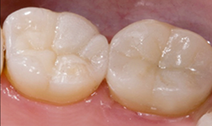Onlays



When decay has affected a larger portion of the tooth’s surface than a filling can adequately cover, inlays or onlays may be needed.
Inlays:
An inlay is recommended when the decay spreads from the inside of the tooth outwards. Material is then inlaid, or filled, into the missing portion to provide support to the structure of the tooth.
Onlays:
When the decay largely affects the outside perimeters of a tooth, onlays are placed on top of the biting surface of the tooth and the outer surfaces as well. Onlays cover the biting surface and act as a temporary crown.
What Are Inlays and Onlays Made Of?
Inlays and onlays are usually made from a composite resin material and porcelain. Not only does porcelain enhance the aesthetics of your smile, but it also provides great strength and support. In some cases, inlays and onlays are developed with an underlying gold base to offer maximum durability. However, with the advancements in dental technology today, porcelain materials sometimes offer equal strength to that of gold.